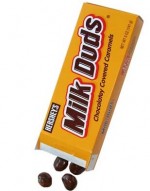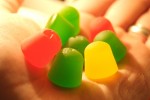 Milk Duds. It kind of sounds like something Linda Richman would say on Coffee Talk: “Milk Duds. They’re neither Milk, nor Duds. Discuss.” But the fact is, they’re both. The “Milk” comes from the high amount of milk used in the product when it was created in 1926, and “Dud” comes from the fact that the candies were meant to be perfectly round, similar to a malted milk ball. Rather than spend copious amounts of money and effort trying to get the candies more spherical, Hershey’s opted to call it a “Dud” instead and simply market it that way. And although there’s still milk in the product, there’s a bit less of it in the past few years since Hershey started using vegetable oil in some products to replicate the expensive cocoa butter used in milk chocolate.
Milk Duds. It kind of sounds like something Linda Richman would say on Coffee Talk: “Milk Duds. They’re neither Milk, nor Duds. Discuss.” But the fact is, they’re both. The “Milk” comes from the high amount of milk used in the product when it was created in 1926, and “Dud” comes from the fact that the candies were meant to be perfectly round, similar to a malted milk ball. Rather than spend copious amounts of money and effort trying to get the candies more spherical, Hershey’s opted to call it a “Dud” instead and simply market it that way. And although there’s still milk in the product, there’s a bit less of it in the past few years since Hershey started using vegetable oil in some products to replicate the expensive cocoa butter used in milk chocolate.Only slightly related: a lady who mistook her hearing aid for a Milk Dud.
(Image credit: I Am Inspired)
Junior Mints. These little bites of minty goodness were favorites of mine long before they plunged into the body cavity of a helpless surgery patient on Seinfeld. In a clever marketing ploy to tie the candy in with the movies, Junior Mints were named after Junior Miss, a show that was all the rage on Broadway at the time. These days, I’d say the namesake confection is much more well-known than the play, even though it eventually became a radio show starring Shirley Temple. Robert Welch, the inventor of the Junior Mint, also created the Sugar Daddy and Sugar Babies. I have nothing against Sugar Babies, but the Junior Mint is far superior, at least when it comes to pop culture: you can find references to the dark chocolate round in Seinfeld, Family Guy, Two and a Half Men, in Jimmy Buffett’s song “Fruitcakes,” in Hüsker Dü’s song “Eiffel Tower High,” in Augusten Burroughs’ book Possible Side Effects and in Fannie Flagg’s Fried Green Tomatoes at the Whistle Stop Cafe. Not too shabby for a mint.
 Sour Patch Kids. The mere mention of Sour Patch Kids makes my mouth water. When the candy was invented in the ’70s, they were known as Mars Men and were sold as loose penny candy in stores. It wasn’t until Cabbage Patch Kid-mania hit in the ’80s that the pucker-inducing gummy was retooled to be shaped like dolls to capitalize on the craze. The first Sour Patch Kid on the package was modeled after the inventor’s son.
Sour Patch Kids. The mere mention of Sour Patch Kids makes my mouth water. When the candy was invented in the ’70s, they were known as Mars Men and were sold as loose penny candy in stores. It wasn’t until Cabbage Patch Kid-mania hit in the ’80s that the pucker-inducing gummy was retooled to be shaped like dolls to capitalize on the craze. The first Sour Patch Kid on the package was modeled after the inventor’s son.(Image credit: Flickr user dklimke)
Sno-Caps, Goobers and Raisinets. The Blumenthal Brother Chocolate Company of Philadelphia really knew how to make good movie theater candy. Goobers – chocolate-covered peanuts – came first in 1925. The success of taking a simple product and dunking it in milk chocolate inspired them to give raisins a shot, and thus Raisinets were born in 1927. Finally, sometime in the late ’20s, Sno-Caps followed under the name “Bob Whites.” The Blumenthal Brother Chocolate Company has long since disbanded – Sno-Caps, Goobers and Raisinets were all acquired by Nestle in 1984 – but their sugary legacy lives on. Bizarrely, Time magazine noted that “All the Blumenthals are excellent pinochle players,” so I guess they had that to fall back on if the whole candy thing didn’t work out.
 Red Vines. I think most licorice lovers can be divided into two categories: those who love Red Vines and those who love Twizzlers. The American Licorice Company introduced Black Licorice Vines in 1914, and those did well enough that they were able to branch out into Raspberry Vines in 1920. They were renamed “Red Vines” in 1952. Despite being around for as long as Elizabeth II has ruled, Red Vines’ first television ad didn’t air until 2008. More fun trivia from the American Licorice Company: they created a licorice shoe for Charlie Chaplin to carve up for a meal in the 1925 movie The Gold Rush.
Red Vines. I think most licorice lovers can be divided into two categories: those who love Red Vines and those who love Twizzlers. The American Licorice Company introduced Black Licorice Vines in 1914, and those did well enough that they were able to branch out into Raspberry Vines in 1920. They were renamed “Red Vines” in 1952. Despite being around for as long as Elizabeth II has ruled, Red Vines’ first television ad didn’t air until 2008. More fun trivia from the American Licorice Company: they created a licorice shoe for Charlie Chaplin to carve up for a meal in the 1925 movie The Gold Rush.(Image credit: Flickr user Incase.)
 Dots and Crows. If you need proof as to how popular these chewy gumdrops are, you need only look to the numbers: the Tootsie Company produces four billion Dots every year. But Tootsie didn’t own the company that invented Dots until 1972 – prior to that, Dots and their sister line, Crows, were a product of the Mason Company. In fact, you’ll occasionally hear some people continue to refer to them as “Mason Dots.” And there’s a nice story that Black Crows, the black licorice-flavored alternative to Dots, should have been called something else entirely. The story goes that the Mason Company informed their candy label printer that they were making a new candy called “Black Rose,” which the printer misheard as “Black Crows.” But Candy Professor nicely debunks this one with a 1911 trademark application from the Mason Company that clearly asks to protect “Black Crows,” not “Black Rose.”
Dots and Crows. If you need proof as to how popular these chewy gumdrops are, you need only look to the numbers: the Tootsie Company produces four billion Dots every year. But Tootsie didn’t own the company that invented Dots until 1972 – prior to that, Dots and their sister line, Crows, were a product of the Mason Company. In fact, you’ll occasionally hear some people continue to refer to them as “Mason Dots.” And there’s a nice story that Black Crows, the black licorice-flavored alternative to Dots, should have been called something else entirely. The story goes that the Mason Company informed their candy label printer that they were making a new candy called “Black Rose,” which the printer misheard as “Black Crows.” But Candy Professor nicely debunks this one with a 1911 trademark application from the Mason Company that clearly asks to protect “Black Crows,” not “Black Rose.”(Image credit: Flickr user pmarkham)

No comments:
Post a Comment